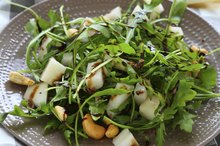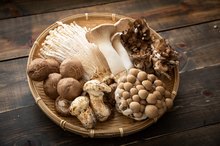Black Radish Side Effects
Black radish, or Raphinus sativus L. var. niger, is a round, white-fleshed, dark-purple-skinned radish. As a member of the cabbage family, black radish contains the same cancer-protective compounds found in broccoli, Brussels sprouts and other members of this large group of temperate-zone vegetables. However, the same chemoprotective substances also have adverse side effects.
Anti-Thyroid or Goitrogenic
Black radish, and all members of the cabbage family -- broccoli, Brussels sprouts, cabbage, Chinese cabbage, kale, mustard, turnip and red radish -- can cause goiter because they all contain glucosinolates. Glucosinolates are modified amino acids. Goiter is the enlargement of the thyroid gland due to iodine deficiency. When radish is chopped or chewed, glucosinolates break down into isothiocyanate, oxazalidine-2-thione, nitrite and thiocyanate ion. Isothiocyanates, oxazalidine-2-thione and isothiocyanate ion can cause goiter, by interfering with the production and secretion of essential thyroid hormones. Without these hormones, the body's ability to burn and use energy is jeopardized.
- Black radish, and all members of the cabbage family -- broccoli, Brussels sprouts, cabbage, Chinese cabbage, kale, mustard, turnip and red radish -- can cause goiter because they all contain glucosinolates.
- Isothiocyanates, oxazalidine-2-thione and isothiocyanate ion can cause goiter, by interfering with the production and secretion of essential thyroid hormones.
Carcinogenic
Basil Allergy Reasons
Learn More
Nitrite, a byproduct of glucosinolate, can cause cancer when it combines with amines forming N-nitroso compounds. Stomach cancer is one of the most common type of cancer associated with nitrosamines. Nitrite also reacts with hemoglobin, producing methmeglobin. Unlike hemoglobin, methmeglobin cannot carry oxygen, so a person with high levels of blood methmeglobin will turn blue, or become cyanotic. People with cyanosis generally have bluish nails, lips and cheeks because their blood is not being properly oxygenated.
- Nitrite, a byproduct of glucosinolate, can cause cancer when it combines with amines forming N-nitroso compounds.
- Unlike hemoglobin, methmeglobin cannot carry oxygen, so a person with high levels of blood methmeglobin will turn blue, or become cyanotic.
Allergen
Diallyl sulfide is mainly found in garlic, but it is also present in black radish as a byproduct of glucosinolate. Diallyl sulfide is an allergen and irritant. The allergy generally begins on the fingertips; it cannot be prevented by using gloves because the compound penetrates most commercial type gloves. It can cause rhinitis, contact dermatitis and allergic asthma in susceptible persons. Because diallyl sulfide allergy is rare, diallyl sulfide has not been included in allergy tests, but it has been recommended for inclusion in tests in the future.
- Diallyl sulfide is mainly found in garlic, but it is also present in black radish as a byproduct of glucosinolate.
- Because diallyl sulfide allergy is rare, diallyl sulfide has not been included in allergy tests, but it has been recommended for inclusion in tests in the future.
Tips and Precautions
Allergic Reactions to Arugula With Mouth Swelling
Learn More
Eat a wide variety of foods including fruits and vegetables every day. Do not eat two servings of vegetables from the same family, such as black radish with broccoli, cabbage, turnip, Brussels sprouts, kohlrabi or kale at the same meal, since you are likely to receive a double dose of glucosinolates. Eat small servings of black radish and vegetables from this vegetable family. Do not eat black radish every day, especially if you have a history of hypothyroidism. Hypothyroidism is a condition caused by an underactive thyroid gland, which results in goiter --- an enlargement of the thyroid gland due to iodine deficiency or eating too many vegetables from the cabbage family. Consult your doctor if you have allergies or iodine deficiency.
- Eat a wide variety of foods including fruits and vegetables every day.
- Hypothyroidism is a condition caused by an underactive thyroid gland, which results in goiter --- an enlargement of the thyroid gland due to iodine deficiency or eating too many vegetables from the cabbage family.
Related Articles
References
- Cornell University; Department of Animal Science:Plant Poisons to Livestock: Glucosinolates
- NCBI; Bookshelf ID:NBK28; Chapter 3: The Thyroid Gland
- "Journal of Environmental Quality"; When Does Nitrate Become a Risk for Humans?; D.S. Powlson, et al.; February 2008
- "American Journal of Clinical Nutrition"; Nitrate in Foods: Harmful or Healthy?; M.B. Katan; July 2009
Resources
- "International Journal of Cancer"; Dietary Nitrate and Nitrites and the Rate of Thyroid Cancer
- "American Journal of Contact Dermatology"; Photocontact Allergy to Diallyl Sulfide
- "Physiology"; Breathtaking TRP Channels:TRPA1 and TRPV1 in Airway Chemosensation and Reflex Control
- "Australian Journal of Dermatology"; Garlic Dermatitis; T.A. Delaney & A. M. Donnelly
Writer Bio
Alicia Richardson, a Dietitians of Canada member, has been writing for over 24 years for such publications as Sir Thomas Roddick Hospital's newsletter, "Canadian Gardening" and "The Georgian." A diabetic and patient-expert learned in lifestyle medicine, she holds a Bachelor of Science in nutrition and health administration.









